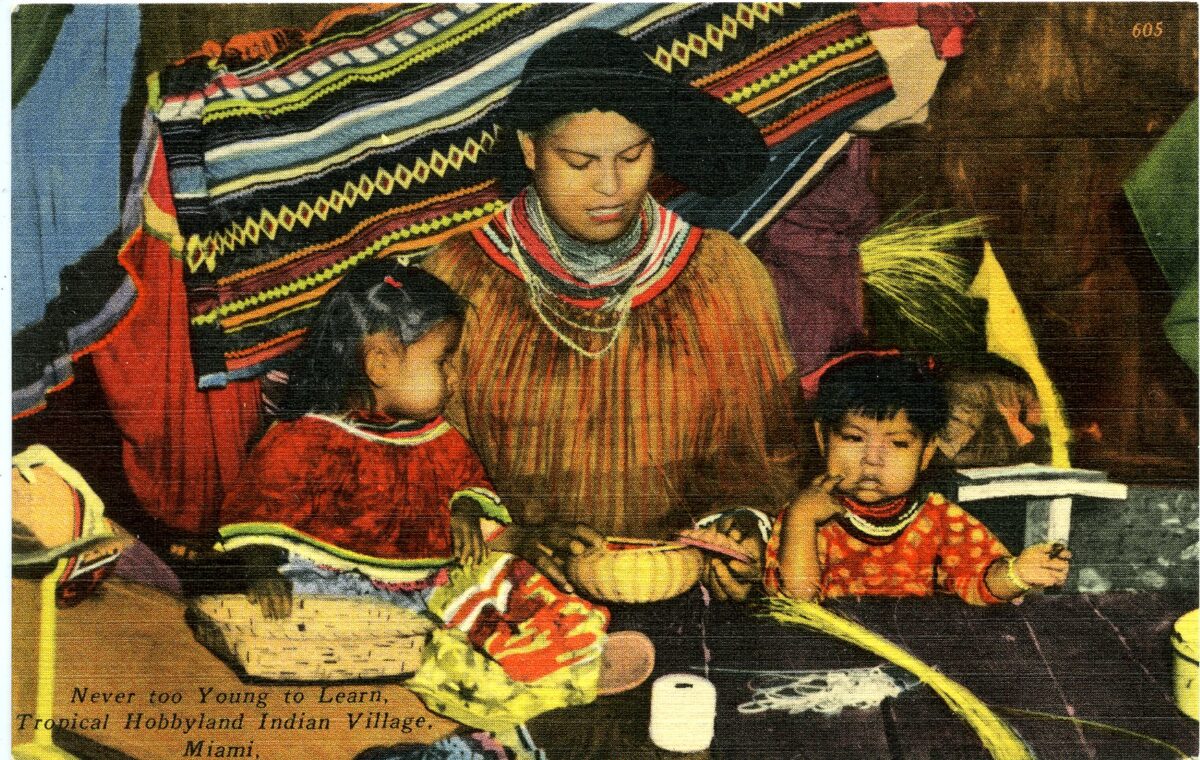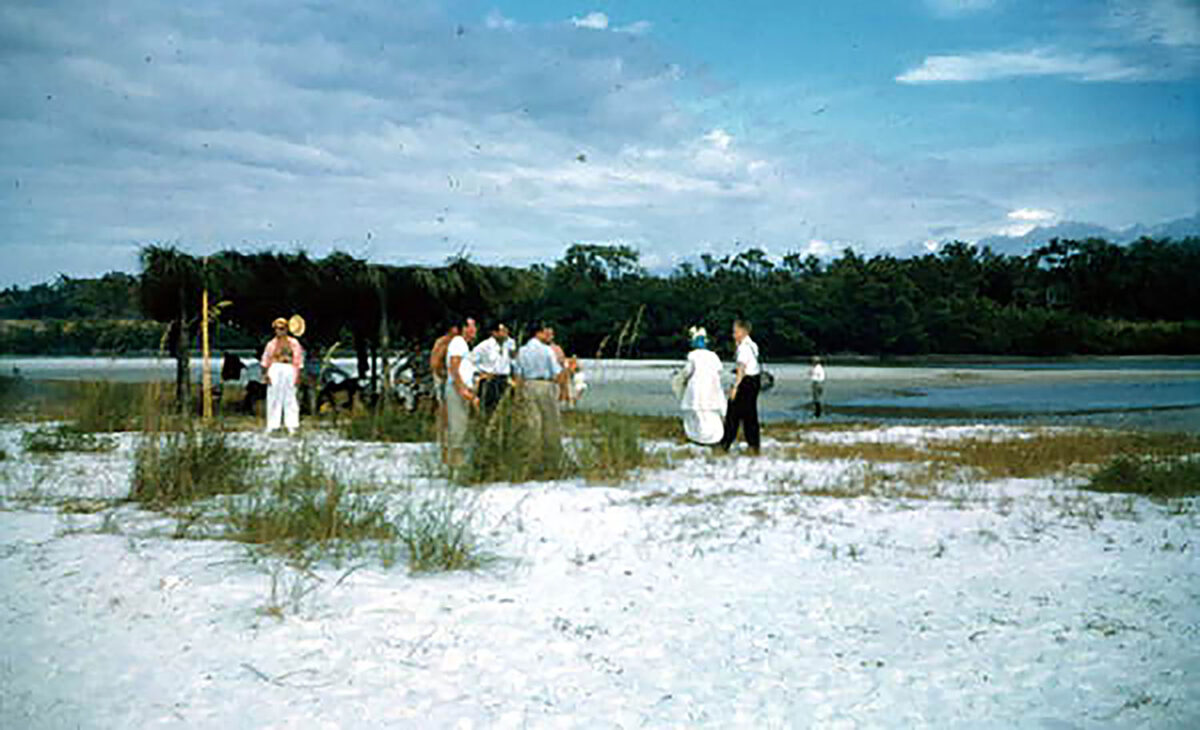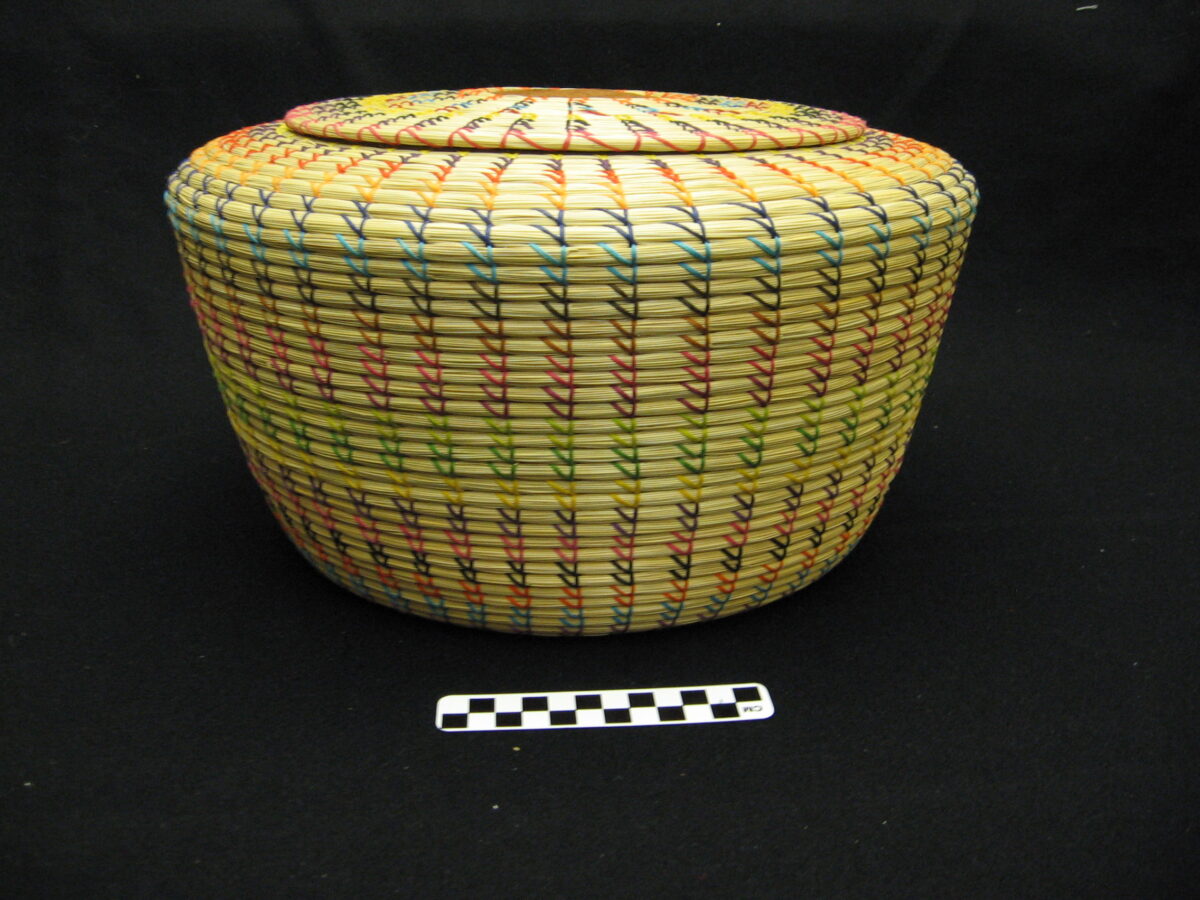
Seminole Makers: Sweetgrass Baskets
Last week, we talked about the history of sweetgrass basket making, and touched on the importance of keeping this Seminole tradition alive. Sweetgrass baskets have a 60-year plus history when they began being sold in tourist camps in the early 20th century. Made of indigenous Florida sweetgrass and palmetto fiber, these baskets instantly catch your eye. They are sturdy, beautiful, and representative of Seminole culture and skill. The passage of time, lowered interest and climate impacts have threatened this traditional craft. But, a few talented artisans are working hard to revive and pass on the knowledge and skills to make sweetgrass baskets. This week, we will focus a bit more on modern Seminole basket makers, how important it is to support traditional crafts and makers, and threats to the craft.
The basket featured above (ATTK catalog 2006.72.1), by renowned basket maker Donna Frank, is a colorful sweetgrass basket with a fitted palmetto fiber and sweetgrass lid. The lid is relatively flat, and the body of the basket has straight sides that flare out slightly towards the top. The base is palmetto fiber, approximately 13 centimeters in diameter. The sweetgrass bundles are stitched in a repeating chevron pattern. There are two rows of each color that is represented. The cotton threads used to stitch the sweetgrass include pink, purple, black, yellow, red, light blue, dark blue, brown, orange, green and light green. It is one of many baskets in the Ah-Tah-Thi-Ki Museum Collection that were either donated or purchased to represent this important art. Preserving items like this in the Museum Collection helps protect pieces of Seminole culture and traditions for decades to come.
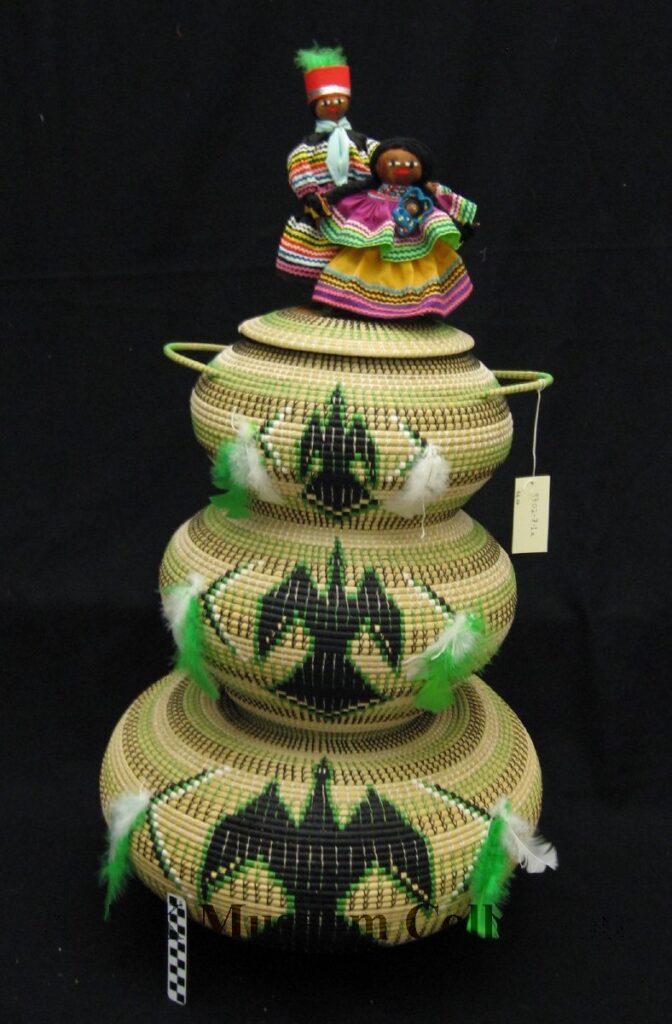
Anhinga Basket, by Linda Beletso, Catalog 1993.15.1, ATTK Museum
Modern Makers
Talented Seminole makers, like Linda Beletso featured in a previous post, pass on these traditions for the next generation. Her baskets can be found in museums, cultural institutions, and even in the homes of celebrities and dignitaries. This basket to the right, made by Beletso, part of the Ah-Tah-Thi-Ki Museum Collection. Beletso created this marvelous basket in only five months, completing it February 1993. It is a large three-tiered basket featuring two dolls in traditional clothing on the lid. You can learn more about doll head baskets in last week’s post. Two delicate handles curve out from under the lid on the uppermost tier. One doll is holding a baby. Black, green, and white stylized anhinga symbols can be found on the body of the basket tiers. This basket is also adorned by feathers around the anhinga.
But, traditional basket-making as an art is threatened by both time and changes in the environment. After the crafting boom of the early 20th century, interest in learning waned in younger people over time. There are very few Seminole sweetgrass basket-makers left. That traditional knowledge was in danger of being lost. Filling the role usually occupied by grandmothers, cultural advisors now help teach students of all ages who want to learn about basket-making but don’t have family to fill that role. Through their own drive and passion for the art, cultural advisors work hard to promote interest in younger people. Basket-making is skilled work. From gathering sweetgrass, processing it, and coiling and stitching the baskets, every step takes specific knowledge. Cultural advisors hope to instill that love and knowledge in young people, to carry on for them.
Gathering

Ahfachkee Students Gathering Sweetgrass, 2015.6.25912, ATTK Museum
Sweetgrass baskets are an iconic part of Seminole art and crafting. But, gathering sweetgrass has become more difficult in recent years. Land development and climate changes have made the delicate grass even more elusive than it was before. Like other parts of the natural ecosystem of Florida, sweetgrass has felt the pinch of a changing world. Sweetgrass, or Muhlenbergia filipes, is found in the scrub undergrowth of high dry parts of Florida. It is easiest to find in the rainy season where the tender grass stands up taller and stronger. Even then, it is hard to spot. It is a long process, and without cultural advisors to pass on the knowledge and training it could fall to history.
In the last few decades, a revival of interest in sweetgrass gathering and basket-making has occurred through the Cultural centers. Students, young and old, come to learn how to spot and gather sweetgrass. Grass needs to be gathered one or two strands at a time, washed and dried, and then sorted into coils. Some participants have never been before. Others remember going with their grandmothers, but lost interest. Each step of the process is important, and passing that along ensures these traditions stay alive. Sweetgrass is wild and can’t be grown or purchased. You have to earn it, through time, knowledge, and grit. Making things quickly isn’t important; the act of making is.
Making Sweetgrass Baskets
After gathering, the sweetgrass is processed. The spaghetti-thin strands are washed in soap and water, and dried in the sun. The green grass shifts to tan as it dries, and after being bundled it is ready to be made into baskets. Palmetto fiber makes up the base of sweetgrass baskets. While easier to find, gathering palmetto fiber is physically demanding and time consuming. Tough and sturdy, palmetto fiber provides structure to the bottom of the baskets. The bundled sweetgrass is then coiled up in rows from the base, and stitched with colored thread. Each artist has their own style of stitching and shaping the baskets. Each artist is distinct. But, the core traditions of sweetgrass basket making are cherished.
Techniques of gathering, washing, drying, coiling, and stitching have been passed down generations. The hands of someone making a basket today are held by all the people who taught and molded them along the way. Traditionally, mothers and grandmothers would teach younger girls like we discussed in our previous post about the history of Seminole basket-making. Other cultural advisors also pass on knowledge through learning trips and hands on teaching. Linda Beletso, who was featured in the Seminole Tribune article previously posted here, was taught by Ethel Frank, Margaret Billie, and later Harriet Billie. Through her, their knowledge has passed on to her daughter Lorraine Posada, and granddaughters Lauren and Lindsay Posada. Generations of knowledge and skill are passed down from elder to younger.
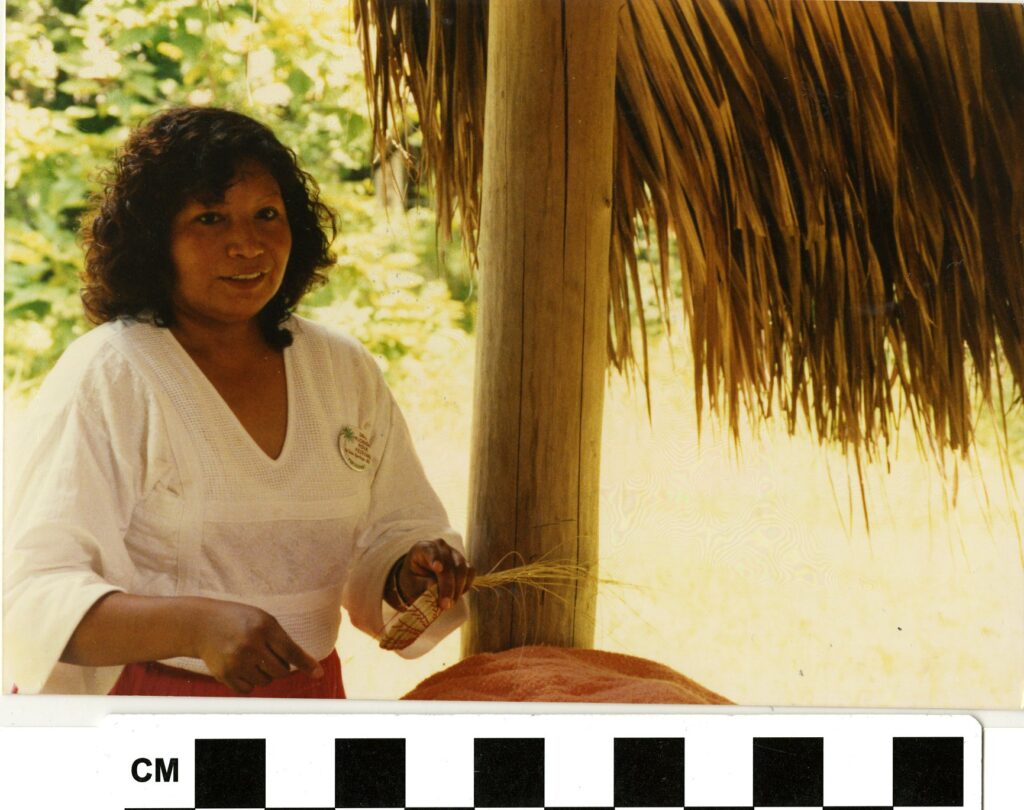
Virginia Tiger making a basket under a chickee, 2015.6.18667, ATTK Museum
The Future of Sweetgrass Baskets
Sweetgrass baskets are bold, colorful, and visually pack a hefty punch. They also represent a lot more than just a decorative basket for the Seminole people and culture. Baskets are the past, and the future of the Seminole Tribe of Florida. Even with the threats presented by shrinking sweetgrass and knowledge loss, tradition is resilient. Hopefully, with dedicated Seminole makers and teachers, generations to come will be able to make and pass on the skills to make sweetgrass baskets. Interest, passion, and investment in younger people is being rekindled. Stay tuned for more posts about Seminole basket-makers coming up! For now, the future of this traditional knowledge is bright.
As always, we encourage you to support Seminole and indigenous makers and crafters. Keeping traditional knowledge alive for the next generation is a vitally important cause made easier by being a good ally. Be intentional about your consumption of indigenous arts and crafts! If you would like to see some Seminole baskets, as well as support Seminole makers, visit the Ah-Tah-Thi-Ki Museum and the Ah-Tah-Thi-Ki Museum Marketplace. We also encourage you to join in on Museum and public Seminole Tribe of Florida events, and peruse the Museum Online Collection.


